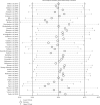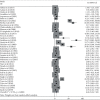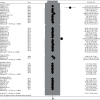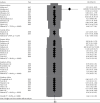Burden of Neural Tube Defects and Their Associated Factors in Africa: A Systematic Review and Meta-Analysis
- PMID: 37388625
- PMCID: PMC10307122
- DOI: 10.1155/2023/9635827
Burden of Neural Tube Defects and Their Associated Factors in Africa: A Systematic Review and Meta-Analysis
Abstract
Background: Neural tube defects are a type of congenital anomaly caused by an abnormality in the development of the brain and spinal cord during embryogenesis. They cause high rates of mortality, morbidity, and lifelong disability. There are several studies carried out worldwide reporting different findings on the burden and associated factors. The aim of this study is to carry out a systematic review and meta-analysis of the burden of neural tube defects and their associated factors in Africa.
Methods: A total of 58 eligible articles were identified systematically using databases such as PubMed, Embase, African Journal Online Library, ProQuest, Cochrane, Google Scopus, Google Scholar, and Grey literature. Extracted data were analyzed using STATA 16.0 statistical software. The heterogeneity of studies was determined using the Cochrane Q test statistic and I2 test statistics with forest plots. A random effects model was used to examine the pooled burden of neural tube defects, subgroups of the region, subtypes of NTDs, sensitivity analysis, and publication bias. The association between NTDs and associated factors was studied using a fixed-effect model.
Results: Fifty-eight studies with a total of 7,150,654 participants in 16 African countries revealed that the pooled burden of neural tube defects was 32.95 per 10,000 births (95% CI: 29.77-36.13). The Eastern African region had the highest burden in the subgroup analysis, with 111.13 per 10,000 births (95% CI: 91.85-130.42). South African countries had the lowest burden, at 11.43 per 10,000 births (95% CI: 7.51-15.34). In subtype analysis, spina bifida had the highest pooled burden at 17.01 per 10,000 births (95 percent CI: 15.00-19.00), while encephalocele had the lowest at 1.66 per 10,000 births (95% CI: 1.12-2.20). Maternal folic acid supplementation (AOR: 0.38; 95% CI: 0.16-0.94), alcohol consumption (AOR: 2.54; 95% CI: 1.08-5.96), maternal age (AOR: 3.54; 95% CI: 1.67-7.47), pesticide exposure (AOR: 2.69; 95% CI: 1.62-4.46), X-ray radiation (AOR: 2.67; 95% CI: 1.05-6.78), and history of stillbirth (AOR: 3.18; 95% CI: 1.11-9.12) were significantly associated with NTDs.
Conclusion: The pooled burden of NTDs in Africa was found to be high. Maternal age, alcohol consumption, pesticide and X-ray radiation exposure, history of stillbirth, and folic acid supplementation were significantly associated with NTDs.
Copyright © 2023 Reta Wakoya and Mekbeb Afework.
Conflict of interest statement
The authors declare that they have no conflicts of interest.
Figures




















Similar articles
-
Birth prevalence and risk factors of neural tube defects in Ethiopia: a systematic review and meta-analysis.BMJ Open. 2023 Nov 7;13(11):e077685. doi: 10.1136/bmjopen-2023-077685. BMJ Open. 2023. PMID: 37940152 Free PMC article.
-
Magnitude and determinants of neural tube defect in Africa: a systematic review and meta-analysis.BMC Pregnancy Childbirth. 2021 Jun 14;21(1):426. doi: 10.1186/s12884-021-03848-9. BMC Pregnancy Childbirth. 2021. PMID: 34126936 Free PMC article.
-
Birth prevalence of neural tube defects in eastern Africa: a systematic review and meta-analysis.BMC Neurol. 2022 Jun 1;22(1):202. doi: 10.1186/s12883-022-02697-z. BMC Neurol. 2022. PMID: 35650541 Free PMC article.
-
Birth prevalence of neural tube defects and associated risk factors in Africa: a systematic review and meta-analysis.BMC Pediatr. 2021 Apr 21;21(1):190. doi: 10.1186/s12887-021-02653-9. BMC Pediatr. 2021. PMID: 33882899 Free PMC article.
-
Birth prevalence and determinants of neural tube defects among newborns in Ethiopia: A systematic review and meta-analysis.PLoS One. 2025 Jan 2;20(1):e0315122. doi: 10.1371/journal.pone.0315122. eCollection 2025. PLoS One. 2025. PMID: 39746047 Free PMC article.
Cited by
-
Presentation and management of neural tube defects in the middle belt of Ghana.Childs Nerv Syst. 2025 Jun 5;41(1):203. doi: 10.1007/s00381-025-06869-3. Childs Nerv Syst. 2025. PMID: 40474002 Free PMC article.
-
Prevalence of Babies Born With Neural Tube Defects and Geospatial Mapping of Therapeutic Services: A Systematic Review.Health Sci Rep. 2025 Apr 16;8(4):e70620. doi: 10.1002/hsr2.70620. eCollection 2025 Apr. Health Sci Rep. 2025. PMID: 40248397 Free PMC article. Review.
-
Birth prevalence and risk factors of neural tube defects in Ethiopia: a systematic review and meta-analysis.BMJ Open. 2023 Nov 7;13(11):e077685. doi: 10.1136/bmjopen-2023-077685. BMJ Open. 2023. PMID: 37940152 Free PMC article.
-
Folic acid supplementation during preconception period in sub-Saharan African countries: A systematic review and meta-analysis.PLoS One. 2025 Jan 31;20(1):e0318422. doi: 10.1371/journal.pone.0318422. eCollection 2025. PLoS One. 2025. PMID: 39888921 Free PMC article.
-
Change in Sexual and Reproductive Health Knowledge among Young Women Using the Conversational Agent "Nthabi" in Lesotho: A Clinical Trial.Res Sq [Preprint]. 2023 Dec 28:rs.3.rs-3788533. doi: 10.21203/rs.3.rs-3788533/v1. Res Sq. 2023. Update in: BMC Glob Public Health. 2024 Sep 5;2(1):60. doi: 10.1186/s44263-024-00091-0. PMID: 38234736 Free PMC article. Updated. Preprint.
References
Publication types
LinkOut - more resources
Full Text Sources

